-
Posts
724 -
Joined
-
Last visited
Content Type
Profiles
Forums
Blogs
Gallery
Events
Store
Posts posted by ehrentitle
-
-
I believe I have an orignial Naples medal (see photos below). Picked it up more than 20 years ago at a gun show not knowing what it was. Do these things have any value? Mine has been sitting is a drawer for years. Kevin
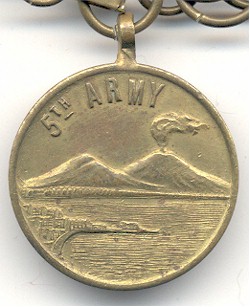
 0
0 -
There's not alot of reference on these medals, or in English.
Kr
Marcus
Marcus here is a link to an excellent website that shows the ribbon bars for most DDR medals with the German name and the English translation: http://www.medals.lava.pl/de/ddr.htm
Kevin
0 -
Reverse - Notice the difference in the pin closure.
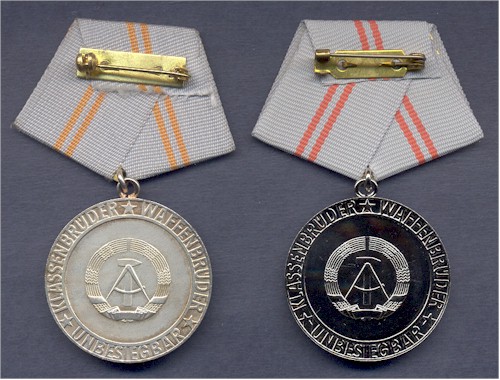
 0
0 -
And i can confirm the statement, the earlier, the better the quality. The threw out zillions of these medals, after the wall was gone already and you could buy the most of them on German ebay. Its really hard to find some earlier issues nowadays, and if, they often go for a crazy prices.
Here is a photo to reinforce Gerd's comment - Medaille der Waffenbrudershaft, Silber - The older one that I purchased in Berlin is on the left and the newer one I purchased on E-bay on the right.
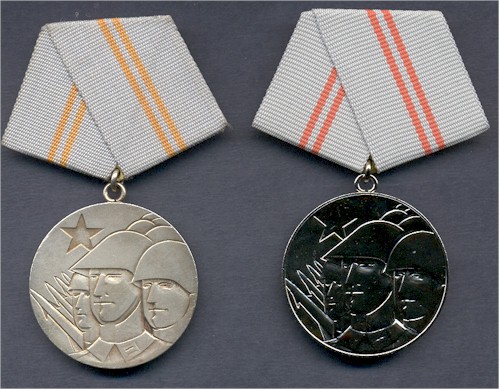
 0
0 -
And reverse - The number is 3523.
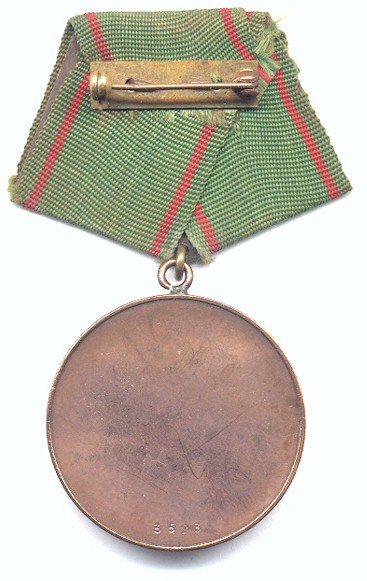
 0
0 -
Here is my early 1950s numbered Grenztruppen Medaille fue vorbildlichen Grenzdienst that I found in a flea market on West Berlin's 17 Juli Stra?e. It was in the bottom of a box full of junk insignia mostly from West Germany. It was also really nast looking, especially the soiled ribbon. So I had to break my rule of not cleaning medals and washed the ribbon and cleaned the layers of dirt and gunk off of the medal. Kevin

 0
0 -
Ed - I do have a ribbon bar that contains the Medaille f?r K?mpfer gegen Faschismus 1933-45. I found it interesting that it is placed first in front of the other NVA medals. I recall hearing that old Anti-Fascist fighters and communist concentration camp victims were revered in the DDR. Kevin

 0
0 -
Medal for the Fighters against Fascism, 1933-45 / Medaille f?r K?mpfer gegen Faschismus 1933-45
Ed - Excellent! I've seen these medals in books, but have never seen one up close. Kevin
0 -
Kevin, this is the first time, that i see numbered DDR-Medals. They seem to be rare, to say at least. Is it possible to trace the owner with that number? What are the numbers, I can?t read them completely?
And i can confirm the statement, the earlier, the better the quality. The threw out zillions of these medals, after the wall was gone already and you could buy the most of them on German ebay. Its really hard to find some earlier issues nowadays, and if, they often go for a crazy prices.
Very nice examples in this thread

Gerd
Gerd - I found this medal bar and the VVO in a coin store on Karl-Marx allee around 1988 when I was stationed in the Berlin Brigade. I picked up several other medals and badges at this store as well. The medals are numbered 00407 and 01360.
I also have an early 1950s numbered Grenztruppen Medaille fue vorbildlichen Grenzdienst that I found in a flea market on West Berlin's 17 Juli Stra?e. I'll post it here if anyone is interested.
Unfortunately I was more interested in Soviet insignia and medals back then and as a result didn't pick up a lot of quality early DDR stuff that is now very difficult to find.
Kevin
0 -
Hi Kevin,
Not my thing DDR so excuse the dumb questions, on your lovely medal bar, the first two appear to be silver ones, medal and ribbon central stripe ? Why would he be issued two of the same, instead of the gold one ?
I recognise the KVP (Kasernierton Volkspolizei) but I've seen this ribbon with the NVA Verdienstmedallie on too ? All reference to Bartels medals book........I read German a little about one word in every ten, but the book confuses me to be honest and doesn't give explanations of anything to any great degree

I've only one .900 medal, the NVA True Dienste (gold), Bartel shows pictures of the traits to period determination on these, but it's hard form his source to determine really.
There's not alot of reference on these medals, or in English.
Kr
Marcus
Marcus - Don't have a clue on why he earned two silver Verdienstmedaille der NVA. Perhaps two periods of achievement/service that were equal in merit. Yes the last medal is the 5 year Medellie fur treue Dienste in der KVP. The simular ribboned medal for the NVA was only awarded from 1956-1957. Both are only found in bronze. From 1957-1959 there was a silver and a bonze medal which like the earlier KVP and NVA medals didn't have the DDR state symbol on the flag, but had the black, red, yellow and green ribbon used in later Medellie fur treue Dienste. From 1960 on to the end they are the standard medals, most of which you see in my ribbon bar, Bronze (5 years), Silver (10 years), Gold (15 years) and Gold with an XX device and color enamel flags (20 years).
You are right about the shortage of references. There were several medal references published by the DDR, but unfortunately they are a bit hard to find. The best is Auszeichnungen der Deutschen Demokratischen Republik, printed in 1979 which shows both civil and military medals in color and black & white plates.
Even the Bartel's references are expensive and hard to come by in the US. I have the older Bartel medal and badge books which I brought back from my service in Berlin.
Kevin
0 -
My VVO in Silver -

 0
0 -
Close up showing numbered medals - They are marked .900 silver on the bottom rim.
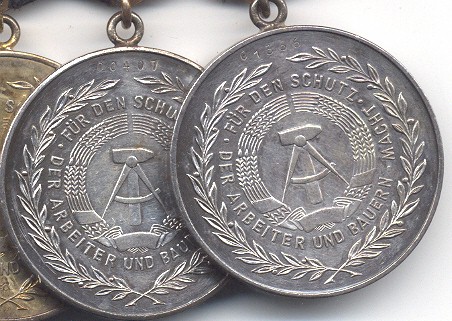
 0
0 -
And the reverse -
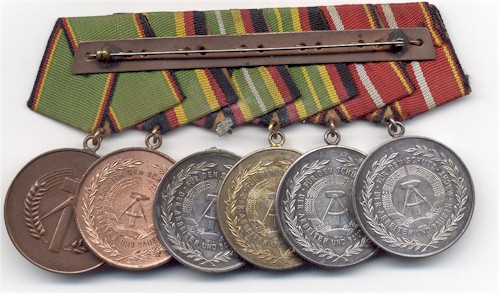
 0
0 -
Here is one of my East German medal bars. It is an excellent older one but does have a flaw...one of the medals has come loose from it's hanger loop. Rule of thumb with DDR medals and insignia...the older the better quality. Stuff from the 1980s really lacks the quality of medals and badges from the 1960s-1970s.
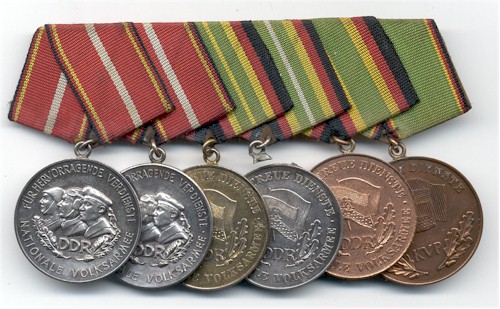
 0
0 -
I have to admit I know nought about DDR medals but as I have some Soviet and German I thought why not....
Looks like 2 long service medals and 2 for outstanding service...any body got any ideas what the last two are for.
A Couple of stasi badges...they came as a group.
I have to admit the quality is better than most...Soviet bars...as are the badges...darn Germans...
Chris
Chris here are the German names of these medals and badges -
Medal Bar: From left to right Medellie fur treue Dienste in der NVA 5 years and 10 years, Verdienstmedaille der NVA Bronze and Silber.
Erinnerungsabzeichen der Ministeriums fur Staatssicherheit (Stasi) for 30 and 35 years
Leistungsabzeichen der NVA
Kampfsportabzeichen der Ministeriums des Innern (Police, Customs, etc...)
Vaterlandisher Verdienstorden (VVO) in Silber, it is an older harder to find .925 silver medal.
Kevin
0 -
Very interesting, I've never seen them come in a box before. Kevin
0 -
My limited number of Volksmarine enlisted shoulder boards. Including an NCO SB with a justice shield and border guard background color of green.

 0
0 -
Good stuff, I spend a few years in the Berlin Brigade where Urban Operations was the focus. I remember reading old WWII U.S. Infantry after action reports warning to stay out of the streets, which were considered killing zone. Instead they recommended blowing "mouse holes" between buildings to move forward. Kevin
0 -
Quite the comprehensive shoulder board collection!!!
Paul
Paul, Thanks much. If only I had the space for uniforms to put all of shoulder boards on. Kevin
0 -
Here is a color selection of Major to Oberst. These shine a bit and are hard to scan properly. The are Armor, Border Guard, Air Force, Infantry, Signal, Air Defense, Airborne and Rear Services (Medical). I have many more types of NVA SBs, but I've run out of steam, this is the last posting for the night.
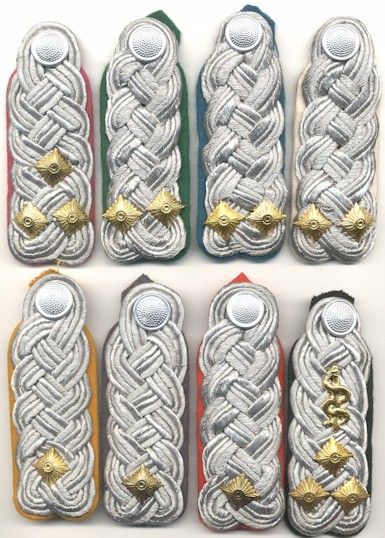
 0
0 -
A selection of color Underleutnant to Hauptmann. Artillery, Signal, Border Guard, Air Force, Stasi and Air Defense.
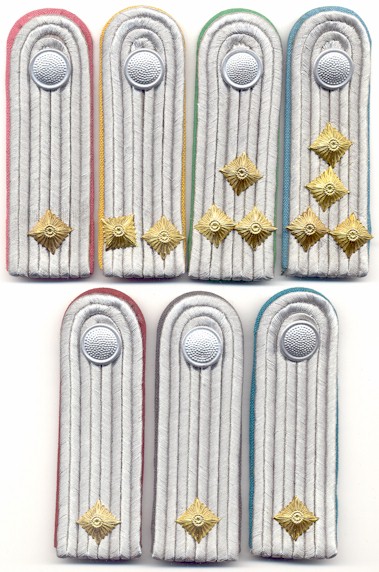
 0
0 -
Scanning boards as I pull them out of the box. Next up a selection of Fahnrich to Stabsoberfahnrich.
Signal, Air Force, Infantry, Stasi, Armor, Airborne and Border Guard . Some have textile backgrounds some wool/felt.

 0
0 -
A selection of Infantry - White, Border Guard - Green, Stasi - Brick Red and Signal - Yellow NCO SBs.
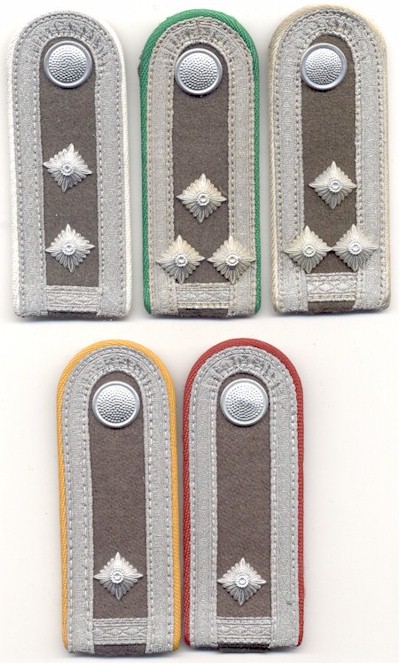
 0
0 -
Nice General Officer sets! Do you have any Luftwaffe General's insignia?
Paul
No, just the General's cap insignia. I was not interested in AF at the time.
 Note that Luftwaffe was a TR & West German term, the NVA used Luftstreitkrafte/Luftverteidigung (Air Forces/Air Defense)0
Note that Luftwaffe was a TR & West German term, the NVA used Luftstreitkrafte/Luftverteidigung (Air Forces/Air Defense)0




unofficial US medals
in United States of America
Posted
Reverse